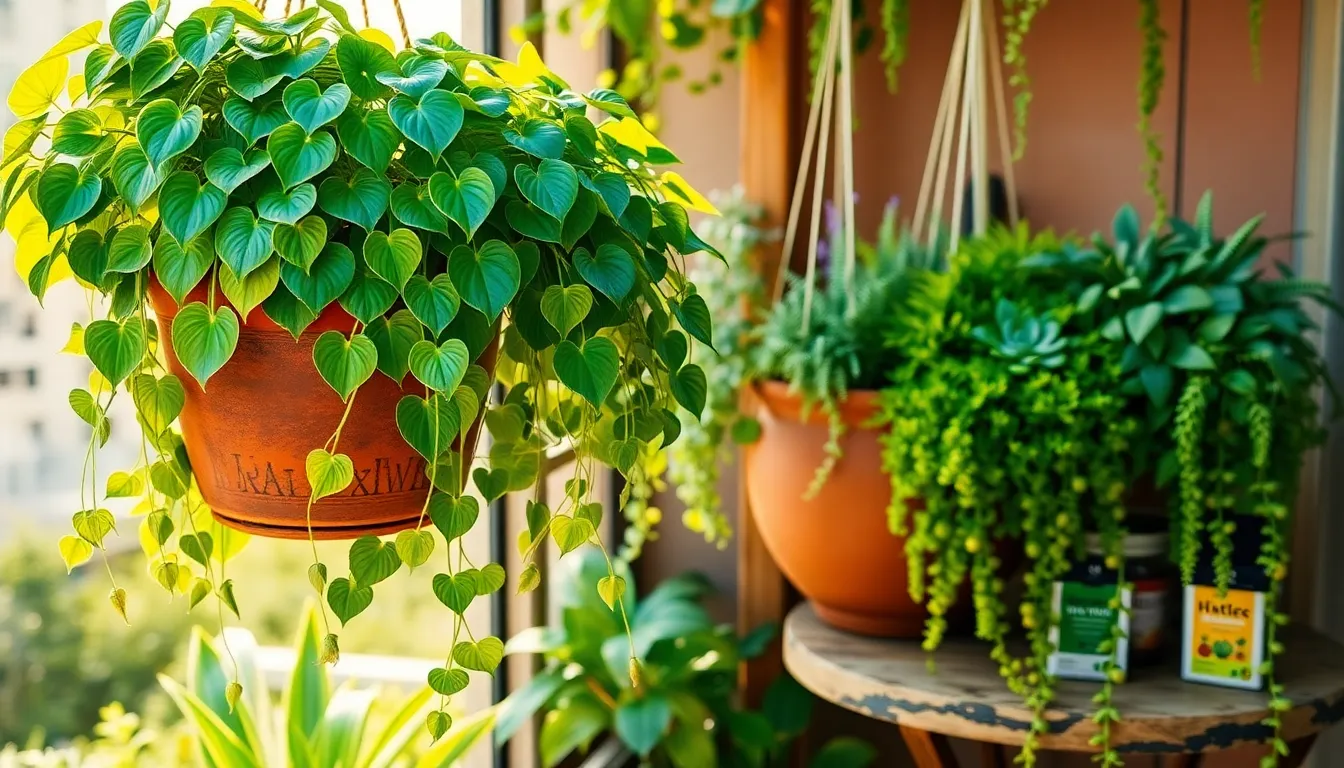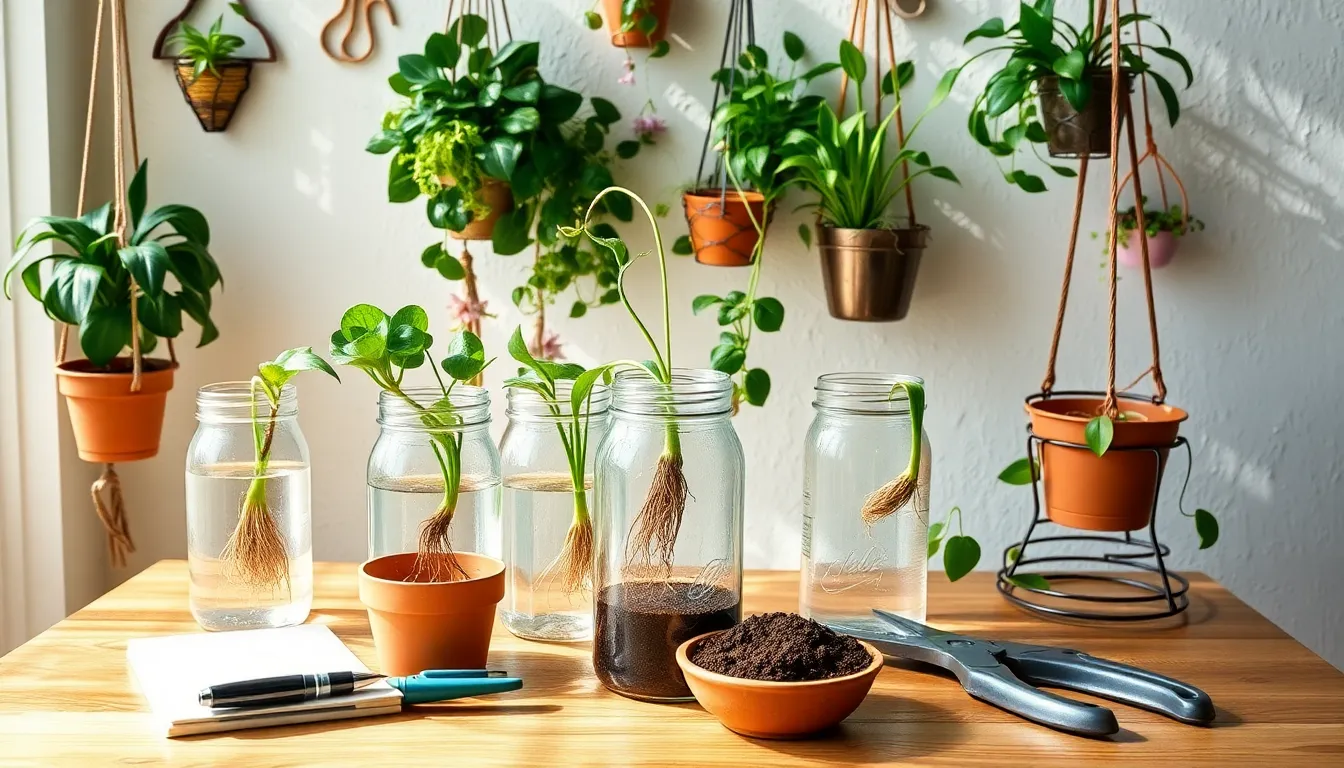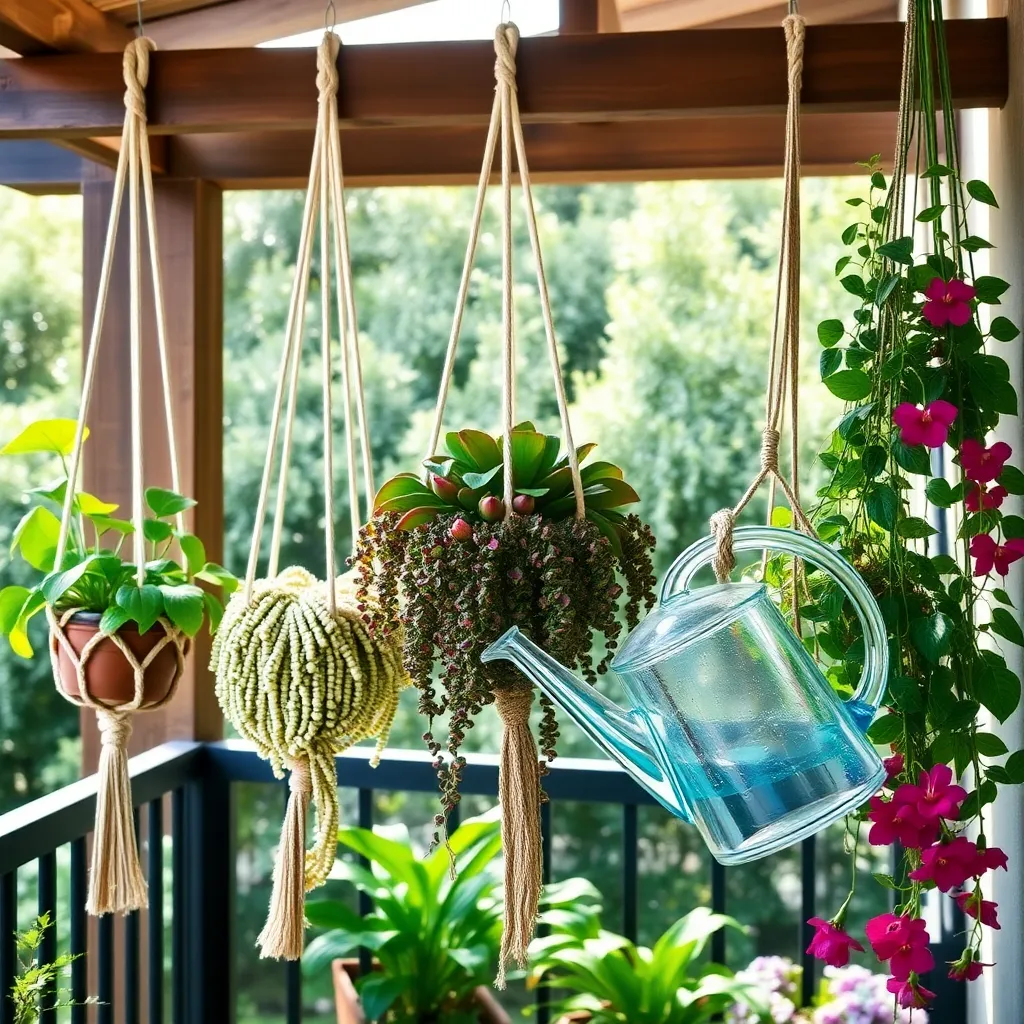Imagine transforming your living space into a lush oasis where each breath feels cleaner and more refreshing. Hanging plants, with their cascading beauty and natural air-purifying abilities, offer a delightful way to enhance your indoor environment while bringing a touch of nature into your home. Whether you’re a seasoned plant enthusiast or just starting your green journey, you’ll find that these plants not only elevate your décor but also significantly improve the quality of the air you breathe.
In our exploration of 14 hanging plants that purify indoor air, you’ll discover a variety of options that suit different lighting conditions and care levels. From the graceful tendrils of the Spider Plant to the resilient charm of English Ivy, each plant has unique characteristics that contribute to a healthier home. You’ll learn practical tips for their care, ensuring they thrive and continue to refresh your space. So, grab your gardening gloves and let’s delve into the world of hanging plants that promise both beauty and well-being.
Understanding Air-Purifying Plants
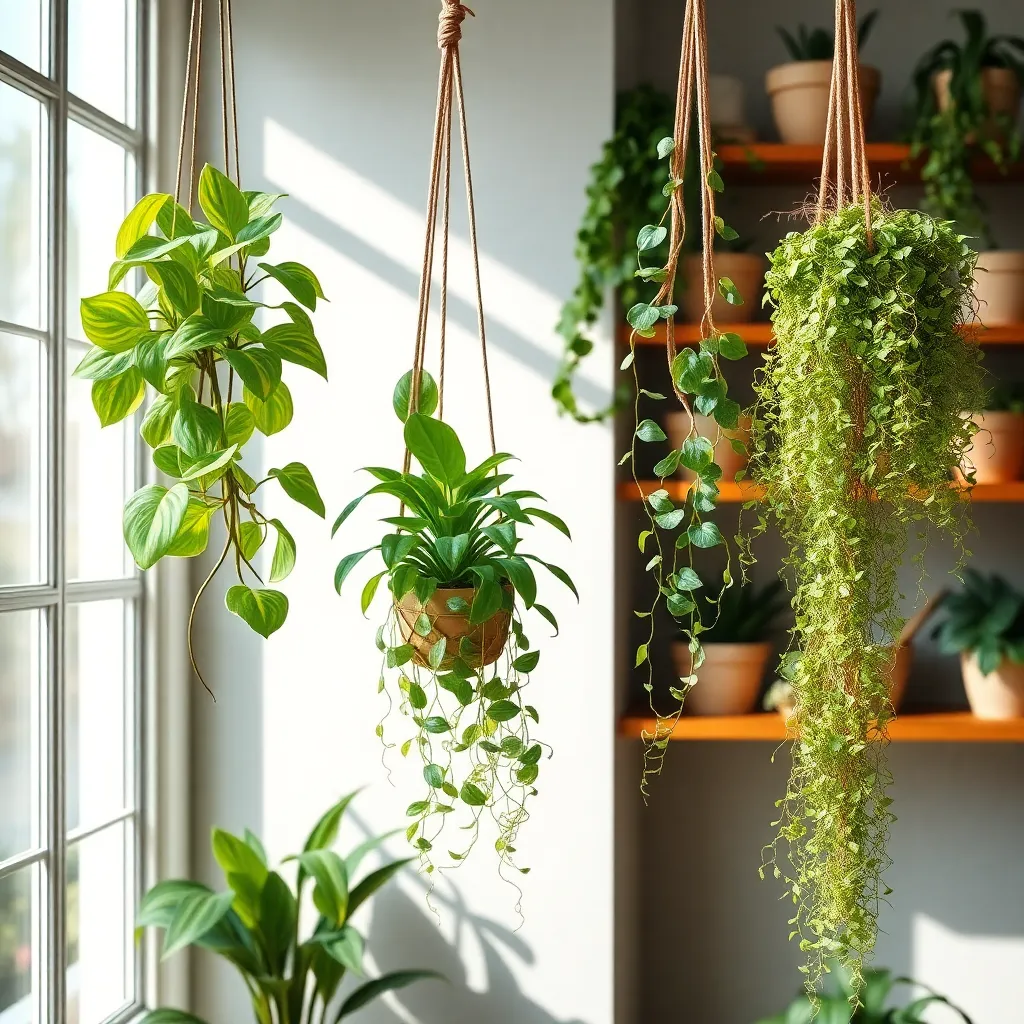
Air-purifying plants are a fantastic addition to any indoor space, not only enhancing aesthetics but also improving air quality. These plants are capable of absorbing toxins, such as formaldehyde and benzene, through their leaves, making them a practical choice for healthier living environments.
To maximize their air-purifying potential, position these plants in areas with good airflow. Place them near windows or vents where they can receive indirect light, which is ideal for most air-purifying species.
Watering plays a crucial role in maintaining healthy air-purifying plants. Most of these plants thrive when the top inch of soil is allowed to dry out between waterings, so it’s essential to check soil moisture regularly.
For beginners, easy-to-care-for options like Spider Plants or Pothos are excellent choices. These plants are forgiving of occasional neglect and can adapt to various light conditions, making them suitable for almost any indoor setting.
Advanced gardeners might explore the use of activated charcoal in their plant’s potting mix. This addition can enhance the plant’s ability to clean the air while also improving soil drainage and root health.
Proper potting is essential; choose containers with drainage holes to prevent root rot and use a well-draining potting mix. Consider a mix of peat moss, perlite, and compost for optimal growth and air purification.
Benefits of Hanging Plants Indoors
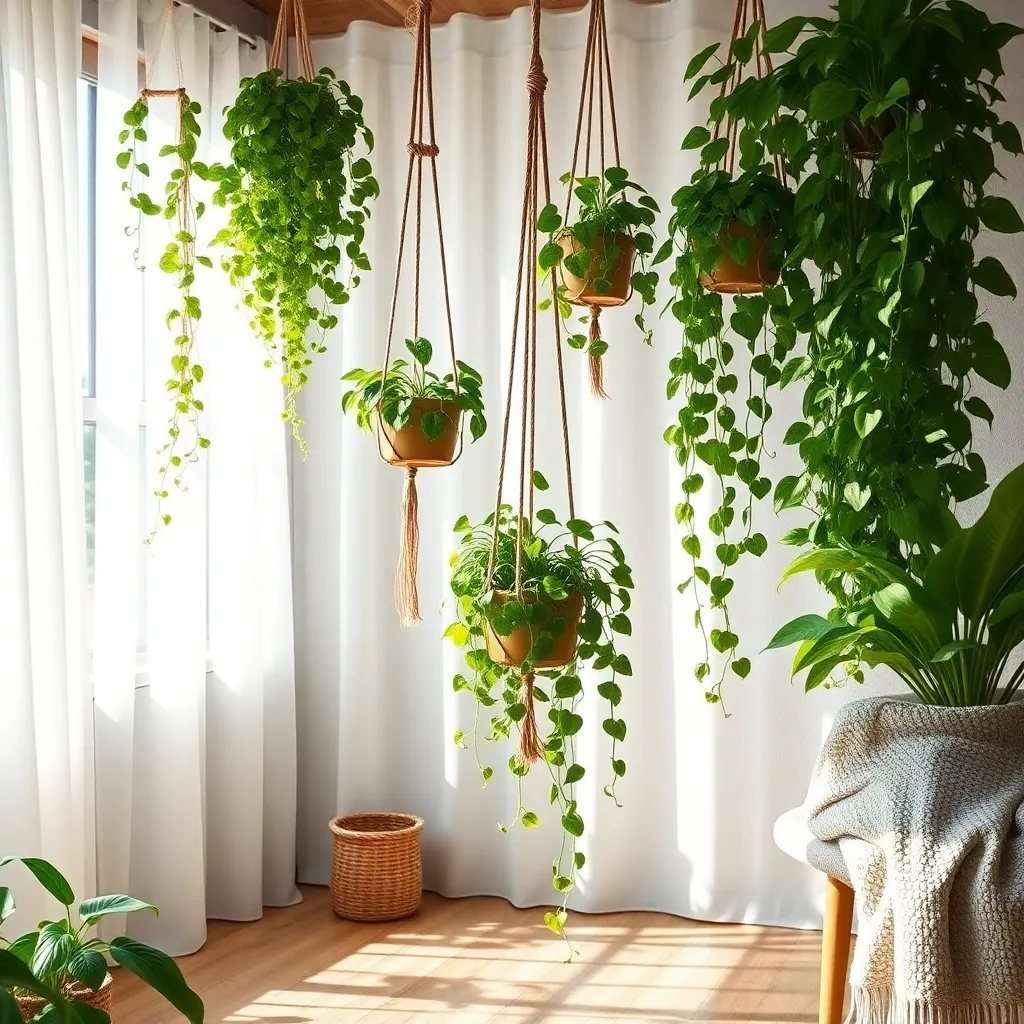
Hanging plants indoors offer numerous benefits, particularly when it comes to maximizing space. By elevating greenery, you can introduce more plants into your home without cluttering surfaces.
These suspended plants also play a significant role in improving air quality, as they can effectively remove toxins and pollutants from the air. This makes them an excellent choice for anyone looking to create a healthier living environment.
For those new to indoor gardening, starting with hanging plants like spider plants or pothos is both easy and rewarding. These plants thrive in indirect light and prefer to dry out between waterings, making them low-maintenance options.
Advanced gardeners might experiment with more demanding species such as Boston ferns, which require higher humidity levels. To maintain these conditions, consider misting the leaves regularly or placing a humidifier nearby.
Choosing the Right Hanging Plants
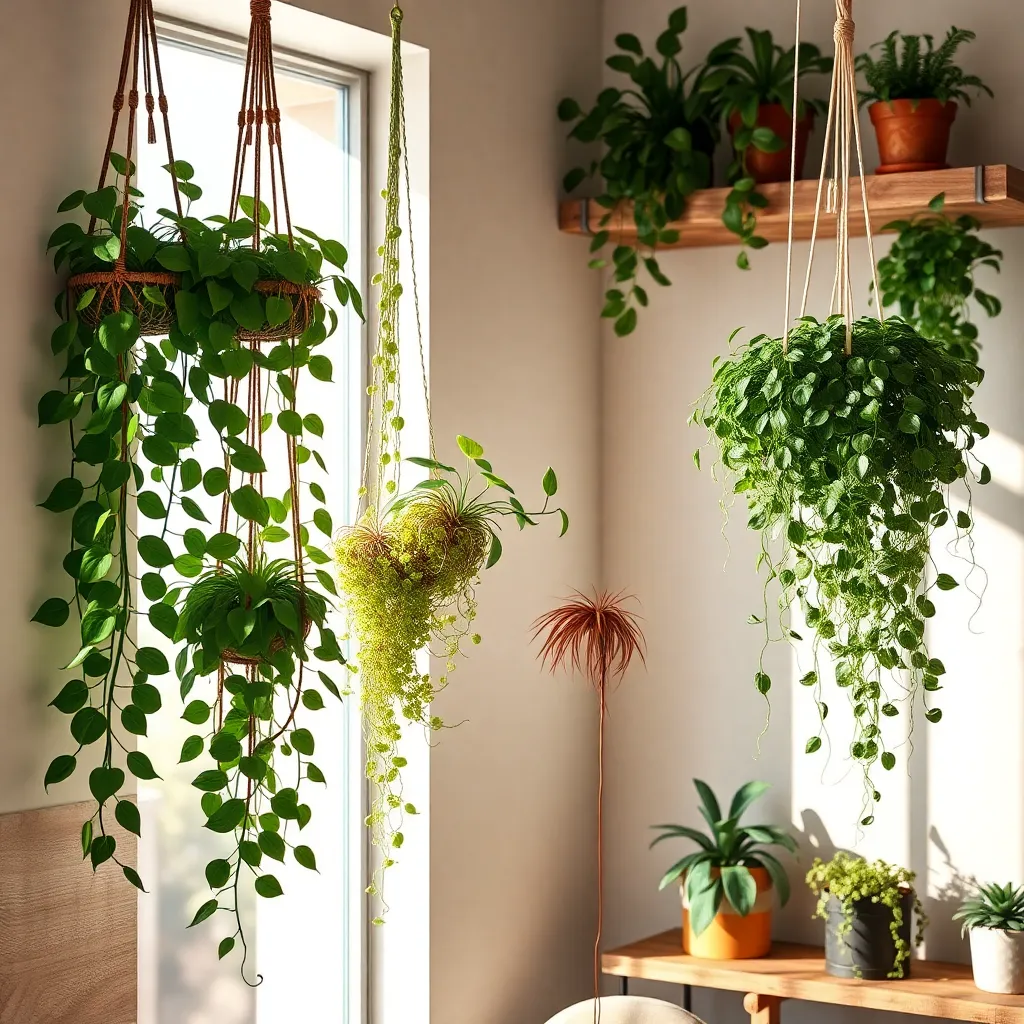
When selecting hanging plants for indoor air purification, consider the light conditions in your space. Plants like the Spider Plant and Boston Fern thrive in bright, indirect sunlight, making them ideal for rooms with ample natural light.
For areas with lower light, opt for Pothos or the Heartleaf Philodendron, which are well-known for their resilience in dimmer settings. These plants not only tolerate low light but also excel at removing toxins, making them excellent choices for improving air quality.
Ensure your chosen plants have the appropriate soil type to thrive. Use a well-draining potting mix for most hanging plants, which often prefer a soil blend containing peat, perlite, and pine bark to support healthy root development.
Pay attention to watering needs to maintain plant health. Typically, hanging plants need watering when the top inch of soil feels dry, but factors like humidity, pot size, and plant type can influence this frequency.
For advanced gardeners, consider rotating your hanging plants every few weeks to ensure even growth and exposure to light. Additionally, regularly misting plants like Boston Ferns can help maintain the humidity levels they thrive in.
Finally, remember to fertilize your plants during their growing season. Using a balanced, water-soluble fertilizer every month during spring and summer will promote lush foliage and robust plant health.
Spider Plant: A Natural Air Filter
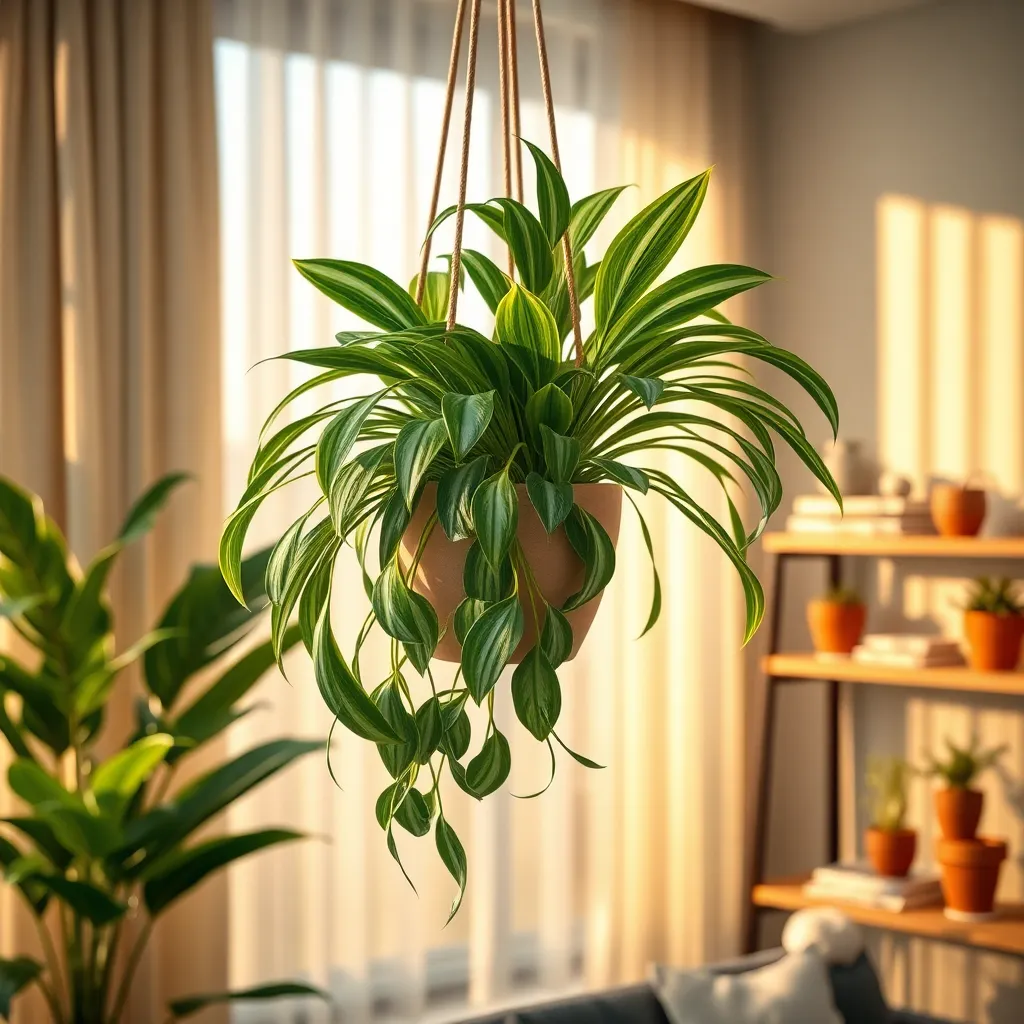
Spider plants are versatile and easy to care for, making them an excellent choice for beginner gardeners. They are known for their ability to filter toxins like formaldehyde and xylene from the air, improving indoor air quality significantly.
To thrive, spider plants prefer bright, indirect light, although they can tolerate lower light conditions. It’s important to plant them in a well-draining potting mix and ensure the pot has drainage holes to prevent root rot.
Watering should be done when the top inch of soil feels dry, approximately once a week. Overwatering can lead to root rot, so allow the soil to dry out between waterings to keep your plant healthy.
If you’re looking to propagate your spider plant, it’s as simple as planting the small offshoots, known as “pups,” into their own pots. This is an excellent way to expand your indoor garden or share plants with friends.
Boston Fern: Humidity Lover
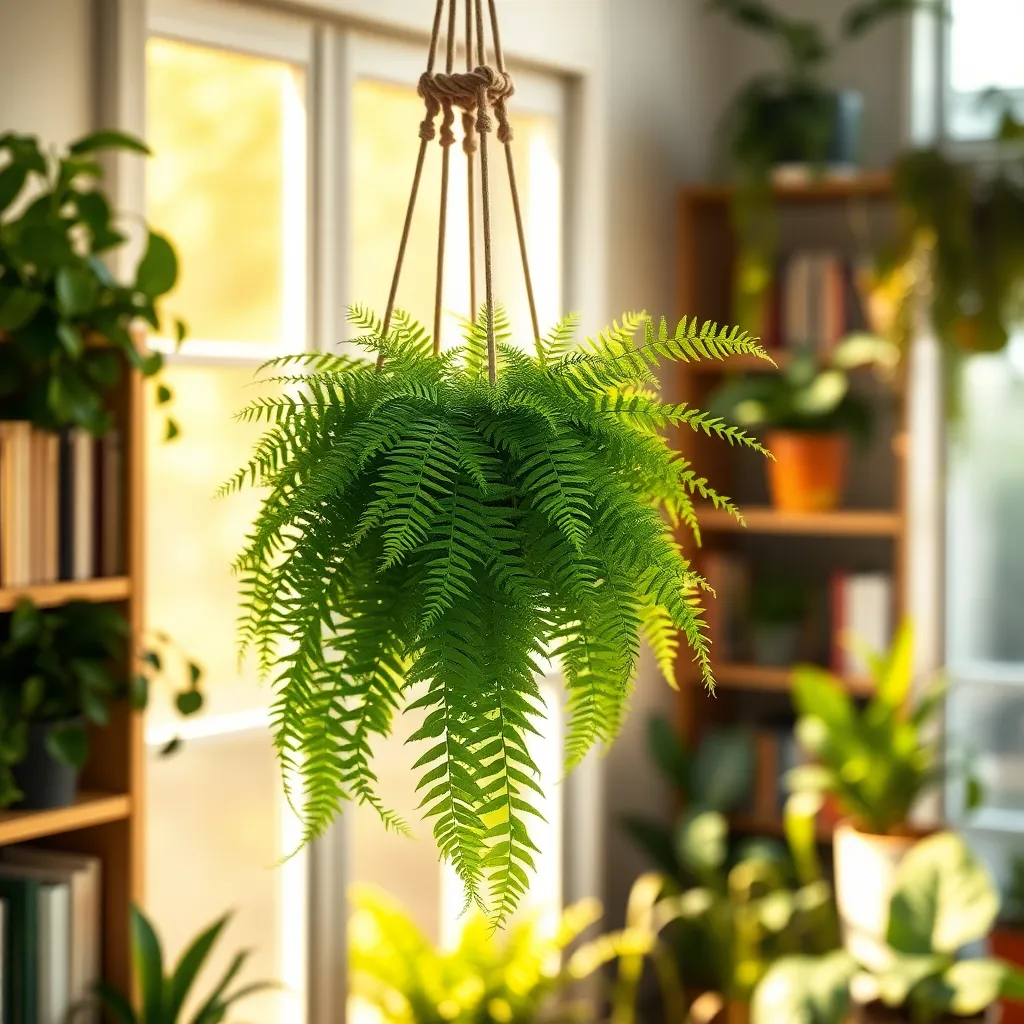
Boston Ferns are a classic choice for hanging plants, known for their lush, arching fronds that can transform any indoor space into a verdant oasis. These ferns thrive in humid environments, making them perfect for bathrooms or kitchens where moisture levels are naturally higher.
To keep your Boston Fern healthy, ensure it receives bright, indirect light, as direct sunlight can scorch its delicate leaves. Water regularly, maintaining consistently moist soil, but avoid waterlogging by using a well-draining potting mix.
For beginners, it’s crucial to monitor humidity levels, especially during the winter months when indoor air tends to dry out. You can increase humidity by misting the plant daily or placing it near a humidity tray filled with water and pebbles.
Advanced gardeners can enhance their fern’s growth by fertilizing monthly with a balanced liquid fertilizer, diluted to half strength. Pruning dead fronds not only keeps the plant looking tidy but also encourages new growth, ensuring your Boston Fern remains a vibrant part of your indoor garden.
English Ivy: Versatile Air Cleanser
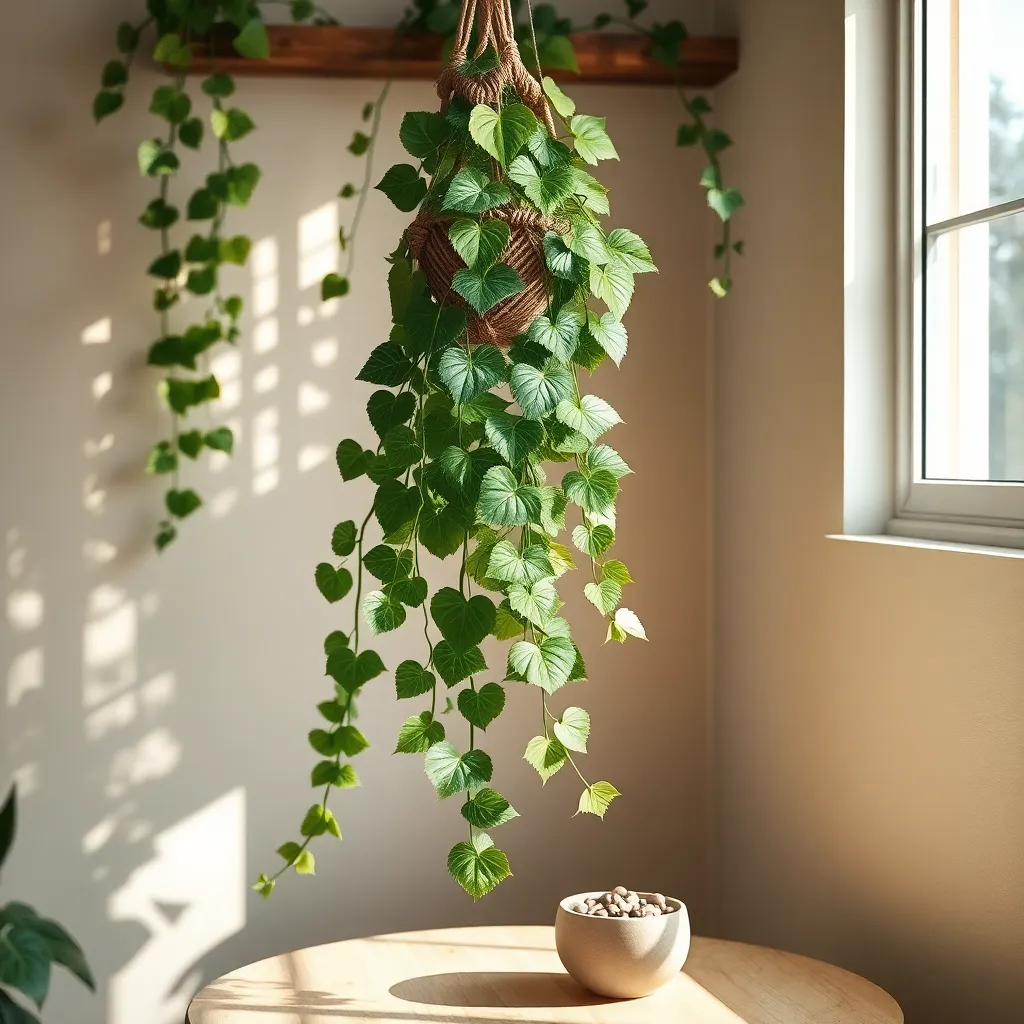
English Ivy is a classic choice for those looking to improve indoor air quality while adding a touch of elegance to their home. Known for its ability to effectively filter toxins like formaldehyde and benzene, English Ivy is both a beautiful and practical addition to any indoor space.
To ensure your English Ivy thrives, place it in a spot where it receives bright, indirect light, as direct sunlight can scorch its leaves. For best results, use a well-draining potting mix and maintain slightly moist soil, allowing the top inch to dry out between waterings.
English Ivy is known for its adaptability and can tolerate a range of indoor conditions, but it truly excels in environments with moderate humidity. If your home is particularly dry, consider misting the plant occasionally or placing it near a humidifier to mimic its natural growing conditions.
For those looking to propagate English Ivy, simply take a cutting with a few leaves and place it in water until roots develop, then transfer to soil. Advanced gardeners can experiment with training the vines to climb or cascade from a hanging basket for a dramatic effect.
Golden Pothos: Low-Light Champion
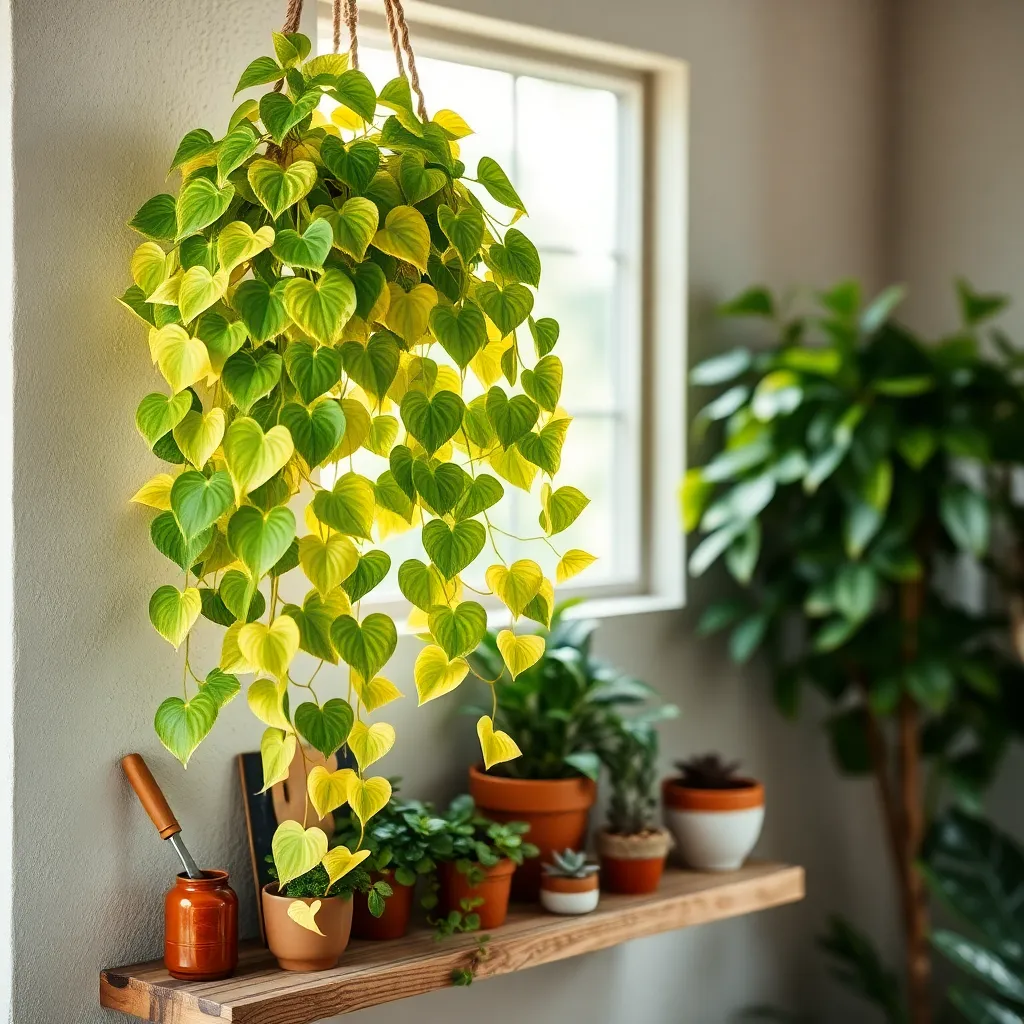
Golden Pothos, often hailed as the “Devil’s Ivy,” is a resilient plant that thrives even in low-light conditions, making it perfect for indoor spaces. Its lush, heart-shaped leaves not only enhance the aesthetic appeal of your home but also contribute to air purification by removing toxins like formaldehyde and benzene.
To ensure your Golden Pothos flourishes, place it in indirect sunlight and water it sparingly, allowing the soil to dry out between waterings. This plant is incredibly forgiving, but for optimal growth, use a well-draining potting mix and ensure your pot has adequate drainage holes.
An excellent choice for beginners, Golden Pothos can adapt to a range of environments, including rooms with artificial lighting. For those looking to expand their plant care skills, consider propagating your pothos by snipping a stem below a node and placing it in water until roots form.
Keep an eye out for yellowing leaves, which may indicate overwatering or a need for more light. Regularly wiping the leaves with a damp cloth will keep them dust-free, allowing the plant to photosynthesize efficiently and maintain its air-purifying benefits.
Peace Lily: Elegant Air Purifier
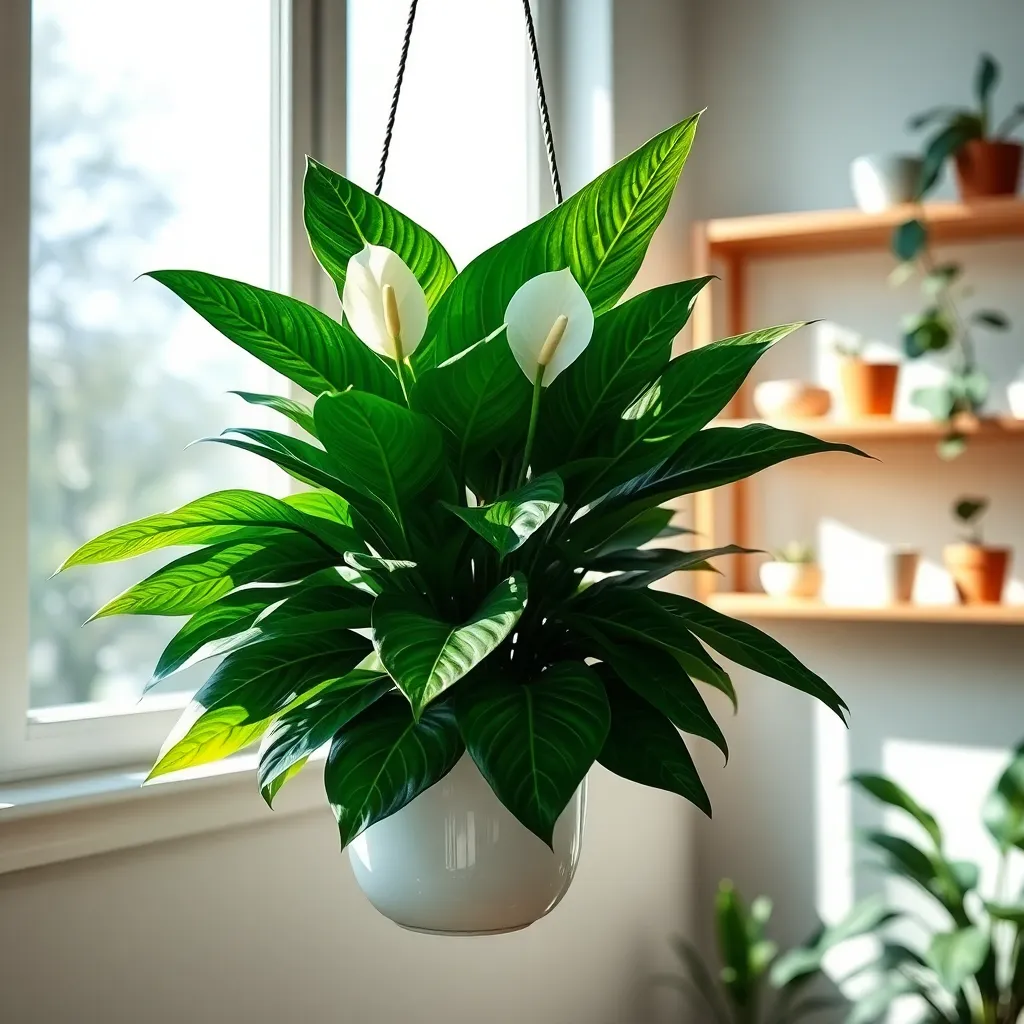
The peace lily, known for its elegant white blooms, is a fantastic choice for purifying indoor air. It efficiently removes toxins such as formaldehyde and benzene from the environment, making it a practical addition to any home.
For optimal growth, place your peace lily in a location with indirect sunlight. Too much direct sunlight can scorch its leaves, while too little can hinder its beautiful blooms.
Peace lilies thrive in well-draining soil, such as a mix of peat moss and perlite. Keep the soil consistently moist, but make sure to avoid waterlogging, which can lead to root rot.
Regularly mist the leaves to maintain humidity, especially during dry months. Every few weeks, wipe the leaves with a damp cloth to keep them dust-free and looking their best.
Heartleaf Philodendron: Easy Care
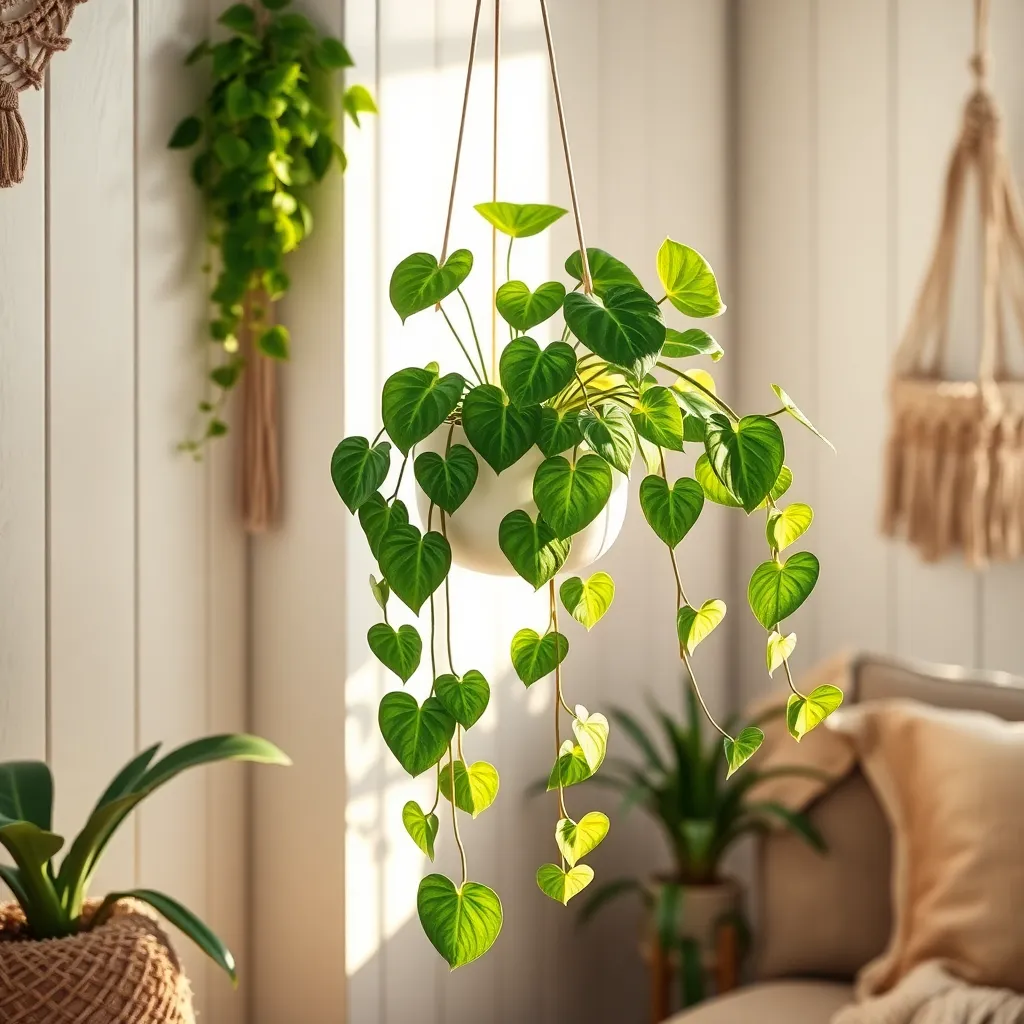
Heartleaf Philodendron is a fantastic choice for anyone seeking a low-maintenance, air-purifying plant. Known for its trailing vines and lush, heart-shaped leaves, it adds a touch of greenery to any indoor space.
To thrive, place your Heartleaf Philodendron in medium to bright indirect light, though it can also tolerate low light conditions. It prefers well-draining soil, so consider a mix of potting soil, peat, and perlite for best results.
Water your Philodendron when the top inch of soil feels dry to the touch, typically about once a week. Be careful not to overwater, as this can lead to root rot—ensure the pot has drainage holes to prevent water from accumulating.
For the more experienced gardener, consider propagating your Philodendron through stem cuttings. Simply cut a piece with at least two nodes, place it in water or soil, and watch new roots develop within a few weeks.
String of Pearls: Unique Aesthetics

String of Pearls, known for its distinctive bead-like foliage, adds a unique charm to any indoor space. Its cascading strands create a visually appealing hanging display that doubles as a natural air purifier.
To thrive, String of Pearls requires bright, indirect sunlight, making it ideal for a sunny windowsill. Watering is crucial; allow the soil to dry out completely between waterings to prevent root rot.
For soil, use a well-draining cactus or succulent mix to support healthy growth and prevent excess moisture retention. Consider adding perlite or sand to enhance drainage and replicate its natural habitat.
Advanced gardeners can propagate String of Pearls easily by snipping a healthy strand and placing it in moist soil. Ensure the cutting receives adequate light and humidity to encourage root development and new growth.
Bird’s Nest Fern: Tropical Vibes
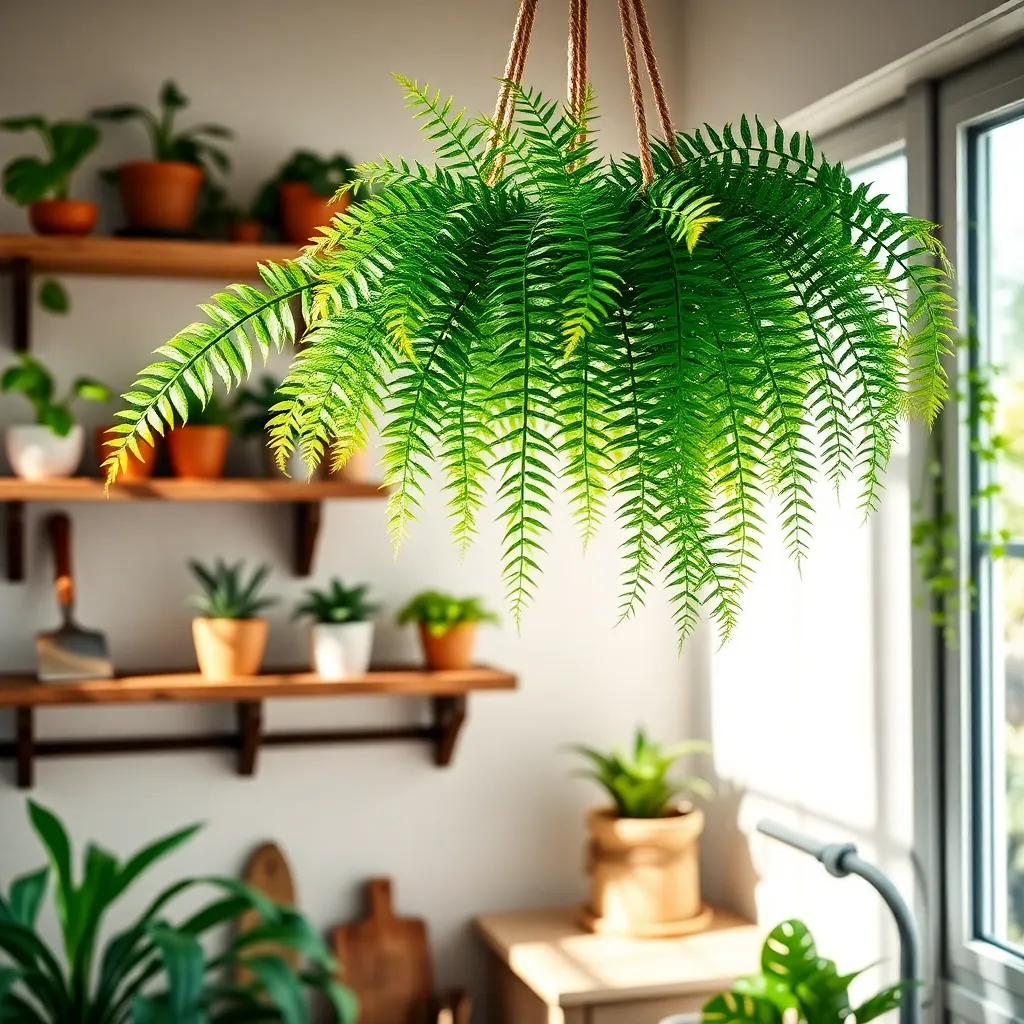
Infuse your indoor spaces with a touch of the tropics by incorporating the Bird’s Nest Fern into your collection. This lush plant not only brings visual appeal but also helps improve air quality, making it a smart choice for any home.
To keep your Bird’s Nest Fern thriving, it’s crucial to mimic its natural humid environment. Place it in a location with indirect light and maintain consistent moisture levels in its soil, ensuring it never completely dries out.
Use a well-draining potting mix, ideally one designed for ferns, and consider adding some orchid bark to enhance aeration. For optimal growth, aim to water it once a week, but adjust the frequency based on humidity levels and temperature.
Advanced gardeners can boost their fern’s health by misting it regularly or using a pebble tray to increase humidity. Additionally, feeding it with a balanced liquid fertilizer every month during the growing season can promote lush, vibrant foliage.
Care Tips for Hanging Plants
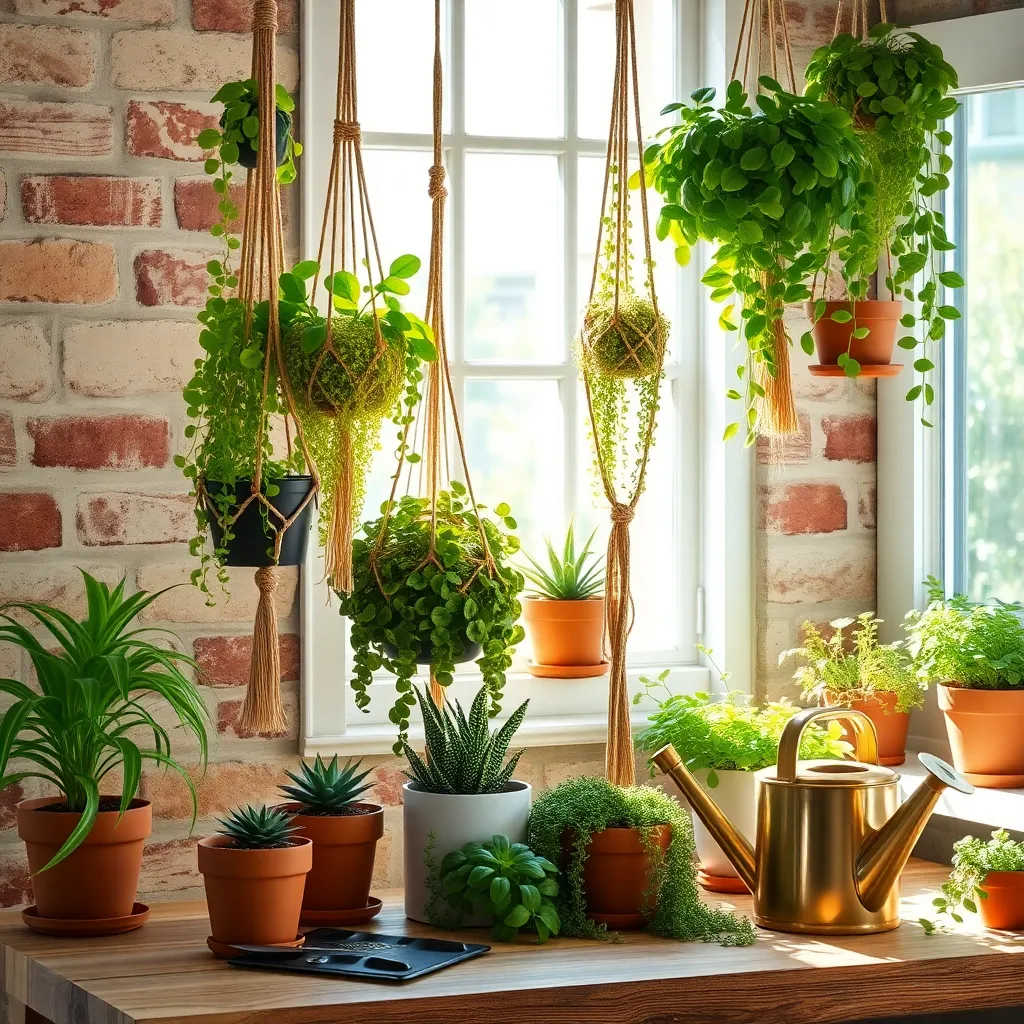
Hanging plants can be a beautiful addition to your indoor space, but they require specific care to thrive and purify your air effectively. Position your hanging plants in areas where they receive appropriate sunlight, as insufficient light can hinder their growth and air-purifying capabilities.
Watering is crucial for hanging plants, as they can dry out faster than their grounded counterparts. Ensure you water them thoroughly by allowing water to flow through the drainage holes, and let the soil dry slightly before watering again to prevent root rot.
Fertilize your hanging plants regularly to support their growth and health. Use a balanced, water-soluble fertilizer every 4 to 6 weeks during the growing season to provide essential nutrients.
To maintain plant health, regularly check for pests, such as spider mites or aphids, which can be more prevalent in indoor settings. Clean the leaves with a damp cloth to remove dust, which can block sunlight and reduce the plant’s ability to photosynthesize effectively.
For advanced care, consider rotating your hanging plants every few weeks to ensure even growth and light distribution. Pruning can also help maintain shape and encourage new growth, so don’t hesitate to trim back any leggy or overgrown vines.
Maximizing Air Purification Benefits
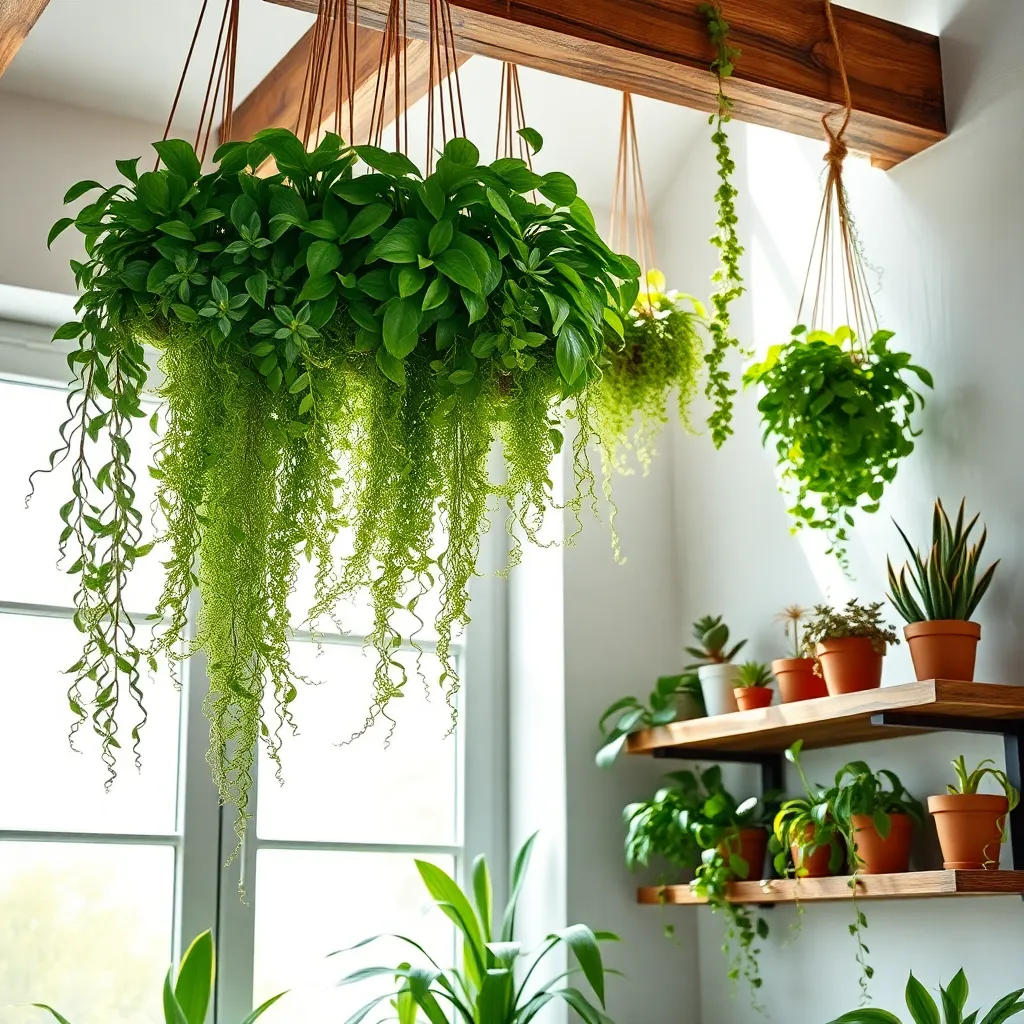
To maximize air purification benefits from your hanging plants, ensure they are placed in areas with good airflow, like near windows or doorways. This helps the plants efficiently filter pollutants and release oxygen, enhancing indoor air quality.
It’s important to select the right hanging plants for air purification, such as English Ivy or Spider Plant, known for their ability to remove toxins like formaldehyde and benzene. For best results, choose a variety of plants that target a range of pollutants.
Regular maintenance is crucial, so remember to dust the leaves of your plants gently with a damp cloth. Clean leaves are more effective at photosynthesis and can absorb airborne toxins more efficiently.
Watering practices also play a vital role in maintaining healthy plants that purify air effectively. Ensure your plants have well-draining soil and water them when the top inch of soil feels dry to the touch.
Advanced gardeners might consider using a humidity tray or misting the plants, as increased humidity can enhance their air-purifying capabilities. This is especially beneficial for plants like Boston Fern, which thrive in higher humidity environments.
Creating Your Hanging Plant Display
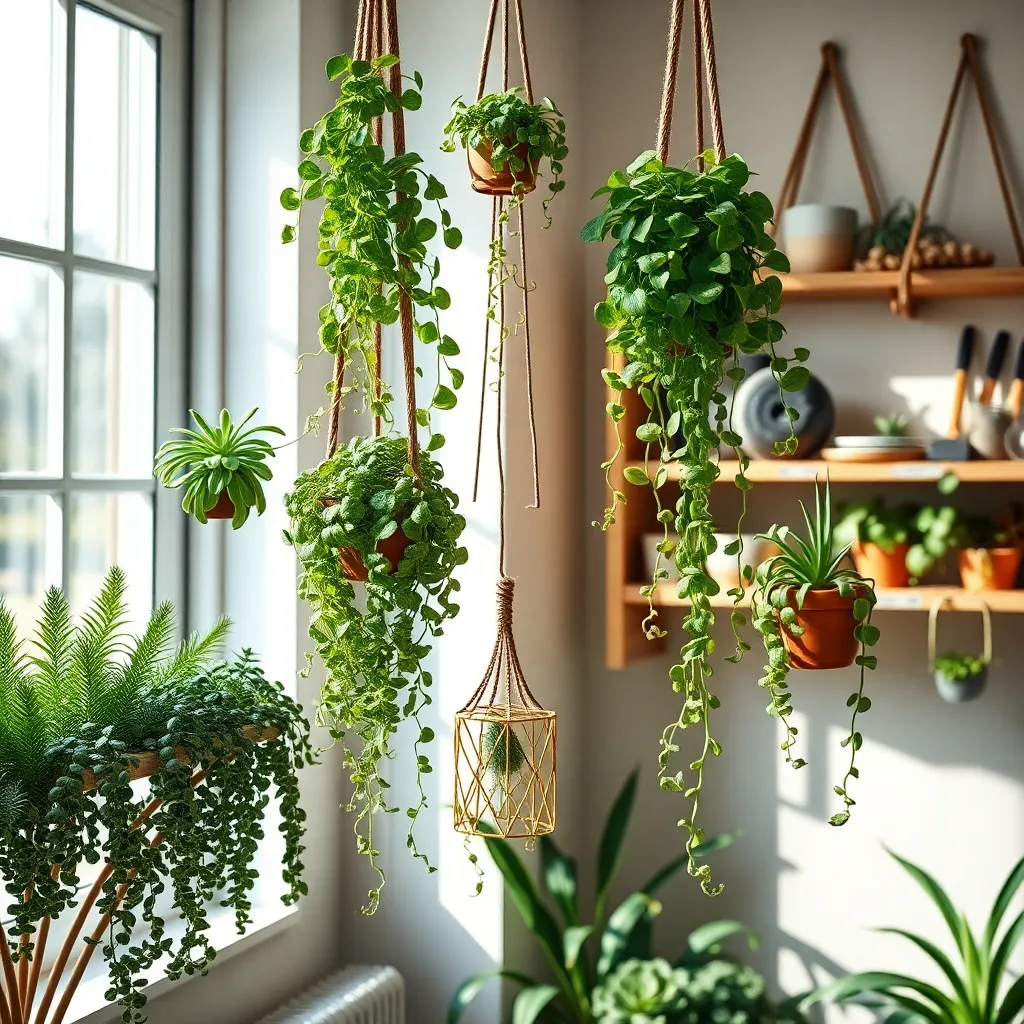
Creating a stunning hanging plant display begins with selecting the right plants for your space. Consider the light conditions in your home and choose plants like the *Spider Plant* for low-light areas or the *Boston Fern* for brighter spots.
Start by gathering your materials: you’ll need sturdy hooks, strong twine or chains, and breathable pots with drainage holes. Ensure that the hooks are securely installed in the ceiling or wall to support the weight of your plants as they grow.
When potting your hanging plants, use a lightweight potting mix to reduce the overall weight of the display. A blend that includes perlite or vermiculite is ideal, as it provides excellent drainage while retaining enough moisture for healthy plant growth.
Regular watering is crucial for hanging plants, but over-watering can lead to root rot. Allow the top inch of soil to dry out between waterings, and make sure excess water is free to drain away by using pots with drainage holes.
Feeding your hanging plants every four to six weeks with a balanced liquid fertilizer will keep them lush and thriving. Dilute the fertilizer to half strength to avoid overwhelming the plants, especially during their active growing seasons in spring and summer.
Consider rotating your hanging plants every few months to ensure even growth and exposure to light. This simple practice helps maintain their shape and encourages even foliage development throughout the plant.
Conclusion: Growing Success with These Plants
In exploring ’14 Hanging Plants That Purify Indoor Air,’ we’ve delved into the enriching bonds that form when nature and nurturing coexist within our homes. Each plant embodies a unique relationship concept: resilience through the Spider Plant, adaptability like the Boston Fern, and mutual growth akin to the English Ivy. We’ve seen how attention, like tending to a Pothos, or the peace fostered by a Peace Lily, parallels the care and tranquility needed in our relationships. These plants remind us of the trust, patience, and love that form the foundation of thriving connections.
As a next step, consider choosing one plant that resonates with your current relationship journey. Place it in your home as a living symbol of your commitment to growth and purity in your emotional bonds.
Remember, the key to flourishing relationships lies in consistent care and attention. Bookmark this article to revisit these valuable insights and refresh your understanding as your relationships evolve.
Looking ahead, embrace the opportunity to cultivate deeper connections, knowing that, like these plants, relationships require nurturing to purify and enrich our lives. Empower yourself with these insights, and watch your relationships blossom.


